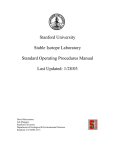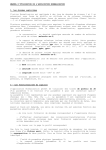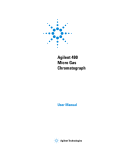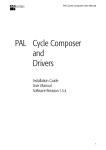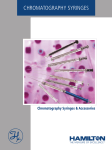Download Rebuttal referee 1
Transcript
We thank the referee for the detailed and constructive comments. Nearly all of them were included
in the revised version and improve the quality of this paper. Referee 1 made many very detailed
comments regarding wording, and most of them were taken over as suggested. We only reply to the
points where we either deviate from the suggestion or where additional information is requested.
Detailed replies to the referee comments. The original comments are reproduced in italics:
Abstract: „Use ppbv instead of ppb (throughout the manuscript)“
Answer: We prefer using ppb, which is the correct abbreviation in atmospheric sciences for the SI
unit of the molecular mixing ratio (nmole/mole). The suggested abbreviation ppbv would
correspond to nl/l, which is not exactly the same if the gases are non-ideal.
Section 2, general comment: In this part you should mention which capillaries are used in which
part of the system:
Answer: We give some additional information where it is adequate, but we feel that this paper
already contains much more details than what is standard in scientific method papers (this is
actually criticized by referee 2). We do not want it to turn into a “how to construct an IRMS
system” user manual. Where we do not give capillary sizes, they are similar to standard IRMS
applications.
page 2439, line 11: „only Teflon ferrules? I assume also nut and fitting?“
Answer: No, this holds indeed for the ferrules only, the fittings are still stainless steel. Only the
ferrules are in direct contact with the „inner“ stainless steel tube.
page 2441, line 22-26: „Is the cryofocus column experiencing a well defined temperature ramp?
The description appears a bit coincidental: given is a 20°C range ( and the remark about the cold
spot). The presented traps offer narrow temperature windows and aer a major advancement of this
manuscript...“
Answer: No, this is not a controlled temperature ramp, but the GC column in the focus experiences
a „ramp“ automatically as a consequence of the cooling and heating cycle. Throughout, the cooling
phase, the temperature gradient is rather large. When the GC reaches the set point temperature at the
mid position, which is used for regulation, the temperature close to the LN2 inlet (column outlet) is
colder and at the LN2 outlet (column inlet) it is warmer (about ±10°C, also depending on the actual
set point). Usually, this temperature gradient is stable, but in our design even variations of several
degree deviation do not affect the quality of the results.
„How quick is the cryofocus heated to +50°C“
Answer: The cryofocus reaches the +50°C target temperature in ~ 3 minutes and the heat out phase
is 6 minutes.
GC: Two (not very differing) columns are mentioned, could another one help to separate the
troublesome substances that are trapped in the front trap? They elute simultaneously with CH4.
Line 3: insert CO2 after “remaining traces”.
Answer: The two columns described (PoraPLOT and PoraBOND) columns are regularly chosen for
these applications. Another column could indeed help to separate the contaminations. The key
criterion for selecting a GC column should be a large retention gap between N2/O2 and CH4.
page2442, line 14:“ One can also argue that section 2.6 could be left out.“
Answer: We agree that section 2.6 is not necessary for the specialist, but it would not be good to
leave out one important part of the system. But we modified the paragraph according to the
suggestions, also including the reference.
Page 2442, line 15f: „use mass/charge (m/z) instead of mass (whole manuscript)“
Answer: Correct, but to improve readability, we prefer to use „mass“ and clearly state that this
stands for the mass-to-charge ratio.
page 2442, line 20: „What is the advantage of the new combustion procedure? Earlier descriptions
(Merritt, Miller, Schäfer, Behrens, …) seem to work well.“
„Why is no Pt catalyst used?“
Answer: When developing up the system, we tested different combustion procedures, including the
ones from the earlier publications as indicated, and also Pt as catalyst. The combustion reactor that
is described in this paper is the one that produced the largest peak area in out system, but it was
beyond our scope to answer why. A further advantage is that we do not need to interrupt
measurements to re-oxidize the reactor manually.
„Copper is not a catalyst but the O2 donor“
Answer: We cannot disagree ('catalyst' removed), but according to Miller [21] Ni-wires provide the
oxygen storage facility. So if not as catalyst, why is Cu then included?
„I think, the melt temperature given here is too low“
Answer: This was corrected, but even at a melting point temperature of 1083°C the argumentation
remains unchanged as the furnace still operates at higher temperature (~1130°C).
page 2444, line 14: „When is the front trap lowered? At the beginning of a dD acquisition or before
a sample's CH4 peak? Is it cooled before/during/after the range in the chromatogram you use as
background range? Is the background of major/minor beams visibly affected before the peak? (it is
the case after the peak) This may lead to artifacts depending on how H3+ contribution is
determined and corrected for. Please see Session's papers mentioned above. The implementation of
the H3+-factor should be explained (see below)“
Answer: The front trap is lowered before the CH4 sample peak. Under clean conditions this does not
influence the background signal, neither before or after the peak. If an effect is seen, this indicates a
contamination, e.g. water eluting from the column. Anyway the background is taken with the front
trap lowered, so this does not introduce artefacts. In any case H3+ issues are of minor importance
(see below)“
„Why is the front trap not used for CO2 analysis?“
Answer: The front trap was introduced to retain remaining traces of condensable oxygen containing
species, particularly H2O, from the pyrolysis reactor. For carbon analyses this is not required since it
does not affect the measurement.
page 2445, line 6: „'sample capillary' should be the one inducing the sample into the mass spec.
The one meant here should be the GC capillary. Please give the length and inner diameter of
sample and refernece capillaries that go the into the mass spec and give pressure of the MS.“
Answer: Capillary nomenclature follows ThermoFinnigan GasBench II manual, i.e. sample
capillary (from column), protection capillary (He, 5 mL/min) and MS capillary (to mass
spectrometer, 0.3 mL/min).
page 2448, line12: „Does ISODAT correct for the H3+ contribution on the basis of the raw data?
How is the H3+ factor determined?“
Section 3: Hydrogen peak integration – In this section I miss information on the H3+ issue for dD
analysis. How is the H3+ factor determined (analytically, software)? How is the correction
implemented in the SPI? Are differences between SPI and ISODAT partly due to the applied H3+
correction? Do I understand correctly, that the H3+ correction is simply included in the overall
linearity correction – the background level adjustment of m/z 3? This would be a valid approach
and should be made clear. If ISODAT offers H3+ corrected time series (raw data files) this should
be stated.
page 2451 line 13: „With the given information I find it impossible to understand this sentence.
What is the issue with the H3+-factor here?“
Answer on H3+ issues: A discussion on the H3+ issues has been dropped, since the finally evaluated
δ-values of sample and calibration gases (after applying the linearity correction via background
level adjustment, averaging over multiple runs and calculating δD relative to SIL) are not very
sensitive to the specific choice of the H3+-factor. Typically, the commonly observed minor
variations in the H3+-factor lead to negligible uncertainties in the δ-values. The dominant correction
is the linearity correction, especially at lower concentrations, so that the largest impact of the H3+factor is on the highest concentrated samples, i.e calibration of δDSiL.
A chapter has been added (ch. 3.1.1) to provide some basic information for completeness.
SPI is also capable to apply a point-wise H3+-factor correction and / or linear H3+ functions even in
combination with several raw data smoothing filters, but none of these options did either improve
the reproducibility and / or the linearity. The H3+-correction and linearity correction are two
different correction taking place at different positions in the evaluation chain.
„For both δ13C and δD I miss information about time shift correction (which setting in ISODAT,
how is it calculated in SPI?)“
Answer: SPIs does not apply time shift corrections. In our system, the maximum signals of mass2
and mass3 coincide (±1 data point, i.e. ~125ms).
page 2448, line 22/23: „It cannot be decided at this point whether this is due to data processing or
a real non-linearity of the physical system.“
Answer: That is correct and it is not decided here. Nevertheless the aim is to minimze nonlinearities.
Page 2449, line 5: „...if the choice of the background level is not perfect, a systematic error is
introduced...“: I do not agree with this statement. You do not necessarily introduce a systematic
error by the background level, which should be chosen by objective means in the first place. Put it
the other way around: Your system introduces non-linearity which could be due to any part of the
preconcentration system (…) and which can be corrected. The presented procedure (…) is just an
empirical correction that could also be done differently, e.g. on the basis of a fit to the peak data
processed without adapting the background level. The results should be the same.
Answer: We suggest that this is a misunderstanding, likely due to the term 'error'. Rather we should
speak of deviations. (Referee 2 also has concerns on this issue.)
It is indeed not possible to decide whether a certain background detection algorithm is “correct”.
We actually do not distinguish whether the observed non-linearity is of physical or mathematical
origin. And of course there are other ways of data reduction without adjusting the background level.
On the other hand, all the different background detection algorithms are based on „objective
means“, but still they introduce significant systematic deviations. Only in quite specific situations
the underlying area-based evaluation algorithms will not produce systematic deviations. If one
assumes that an ideal mathematical background level exists (i.e. the one leading to the correct
result) than a BGD, which is not capable of detecting this ideal level, does create systematic errors.
Comments on alternative fits see below page 2450, line19f
„Nevertheless, the presented method of adapting the background level for a batch is ok, as long as
the shift is identical for all standards and samples.“
Answer: Only one correction parameter for all peaks of a batch is used.
Page 2449, line16: „Do you really define the range of the background for each peak individually?
... [full comment not reproduced here]“
Answer: No, SPI does neither define the position, nor size of the background history for each single
peak, individually.
„Otherwise it should be explained that the background level is formidable stable not only during
one chromatogram, but also over days and weeks. In Line 13 page 2449 it is stated the the
background level is stable, and I assume that referencing from run to run is not biased. Assuming
identical background histories throughout different chromatograms raises the question why SPI
should find an individual background range for each peak. ...“
Answer: Although the background is very stable it is not that stable over days and weeks, If it was,
then this would indeed make SPI dispensable.
„As I understand, the background range could be easily defined as a constant range (and offset)
before peak starts, without compromises in precision“.
Answer: This is actually done. The parameters (offset, length, also detection method, filter, ...) stay
constant over the whole batch and are defined for each peak POSITION / NUMBER in the
chromatogram(s) once. - The paragraph is slightly modified for clarification.
page 2450, line 11: „The background linearity correction is based on the m/z 3 beam. … I wonder
why the minor beam is used for the concentration determination? …“
Answer: The concentration determination relies on both beams. As it is written, only the
background of the minor beam is modified, so that the concentration determination, which is
dominated by the major beam is least influenced. The major beam is not modified.
page 2450, line19f: „Which traditional non-linearity corrections do you refer to? It is possible to
correct for non-linearity effects without knowing the sample's concentration by using directly the
different peak sizes of standard measurements. See e.g. Potter … 2004?“
Answer: This paragraph was rewritten for clarification.
The term „traditional non-linearity corrections“ refers to the common strategy, mentioned by the
referee above: „on the basis of a fit to peak data“. In this case „peak data“ is related to the sample
amount, e.g. concentration, peak width, amplitude or area. In this case a fit function needs to be
defined that represents the linearity correction. For this special case, commonly applied simple
analytical functions did not work well and using higher-terms/order (rational) functions introduces
additional parameters.
The correction method that we have developed is superior, because it is able to correct all peaks at
any area / size of any isotope ratio (at least within the observed limits) by adjusting one single
parameter with excellent results.
Page 2452, line 21: „ According to the IT principle the lower hydrogen yield is also true for the
standard, therefore this should cancel. How can you proof the combustion to be complete? ...“
Answer: The argumentation was indeed misleading and has been changed. The main reason is that
the carbon-derived concentration agrees much better with high-precision results from other
laboratories.
Page 2453, line 26: „... Another explanation could be that CH4 free air has some impurity.“
Answer: Of course, this is also a possibility and has been mentioned.





